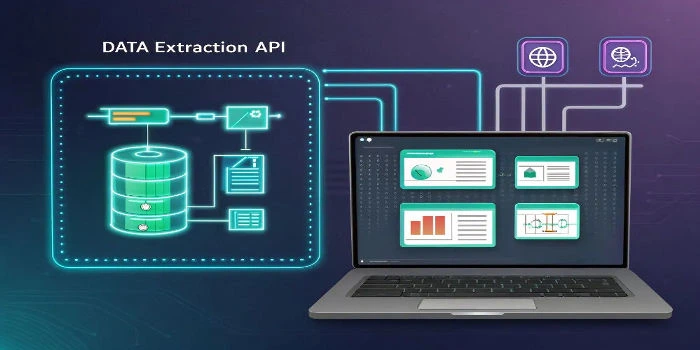20-22 Wenlock Road, LONDON, N1 7GU
20-22 Wenlock Road, LONDON, N1 7GU

In today’s data-driven world, having instant access to relevant, clean, and structured data is no longer a luxury—it’s a necessity. Businesses that harness the power of a data extraction API gain a significant edge in automating data collection, minimizing manual effort, and speeding up decision-making. In this comprehensive guide, we’ll walk you through everything you need to know to streamline your API data extraction process.
Whether you’re a developer, data analyst, or decision-maker, understanding how to work with a data extraction API can transform the way your business handles information.
A data extraction API is a programmatic interface that allows applications to fetch, parse, and store data from external sources—be it websites, databases, cloud applications, or enterprise platforms. These APIs make data integration seamless by eliminating the need for manual data scraping or downloading files.
With the right data extraction API, businesses can automate everything from lead generation and competitor tracking to product listing updates and real-time reporting.
Utilizing a data extraction API offers numerous benefits beyond just automation. Below, we explore the primary reasons why businesses are shifting toward API-based data extraction methods.
Manual data entry is time-consuming and error-prone. A data extraction API ensures consistent data collection at high speed and accuracy.
Whether you need to extract data from one source or thousands, APIs can scale with your needs. You can configure them to suit your data formatting, frequency, and volume requirements.
Modern data extraction APIs can easily be integrated into CRMs, ERPs, BI tools, and other platforms, ensuring that data flows smoothly across your organization.
Many APIs provide real-time or near real-time data, which is essential for businesses relying on up-to-date information for analytics or operational decisions.
Selecting the right data extraction API is critical to streamlining your API data extraction process. Here’s what to consider.
When evaluating your options, focus on features, compatibility, cost-effectiveness, and support.
Make sure the data extraction API supports the platforms or websites you want to extract data from. Some APIs are specialized for eCommerce, social media, finance, etc.
Some APIs offer built-in connectors to platforms like Shopify, Amazon, Google Analytics, or Salesforce, which can save a lot of development time.
Understand how many API calls are included in your subscription and the cost of exceeding limits. Pay-as-you-go models may be better for startups, while enterprises might need custom plans.
Ensure the data extraction API delivers clean, structured data in formats compatible with your systems—like JSON, XML, or CSV.
Implementing a data extraction API may seem complex at first, but the process becomes straightforward with a systematic approach.
Follow these steps to streamline your API data extraction process effectively.
Determine what data you need, how often you need it, and where it should be stored. This sets the foundation for your API integration.
Choose a data extraction API that matches your requirements. Review documentation, test endpoints, and look for customer reviews.
Most APIs require an authentication token or key. Store this securely and integrate it into your requests.
Set parameters such as filters, fields, limits, and time ranges to tailor your data pull.
Use Python, Node.js, or tools automate and test your API extraction workflows.
Track usage, handle errors gracefully, and update integrations when the API provider makes changes.
A powerful data extraction API can serve multiple industries and functions. Here are some common real-world applications.
Retailers use data extraction APIs to monitor competitor pricing, product listings, and reviews.
Marketers automate data collection from directories, social media, and news sites to feed CRM systems.
Finance teams use APIs to pull stock prices, exchange rates, or economic indicators for modeling and reporting.
Media organizations aggregate news articles or social trends across various channels using data extraction APIs.
Maximizing the effectiveness of your data extraction API requires more than just integration—it’s about optimization and scalability.
Here are some best practices to keep your process smooth and reliable.
Avoid timeouts and blocked IPs by respecting pagination and API rate limits.
Implement error handling logic and maintain logs to troubleshoot issues efficiently.
Ensure the data extracted matches expected formats and values. Clean data is critical for downstream systems.
Use cron jobs or workflow tools to schedule API calls during off-peak hours or based on business events.
Keep your credentials secure using environment variables or vault tools.
Choosing and implementing a data extraction API is one of the smartest moves for organizations aiming to scale their operations and gain deeper insights through automation. By following the best practices shared in this guide, you can successfully streamline your API data extraction process, ensure data accuracy, and drive smarter business decisions.
Ready to take your data operations to the next level? Start exploring a data extraction API solution that aligns with your goals today.
A data extraction API is used to automatically retrieve structured data from websites, apps, or databases, making it ideal for automating data collection processes across industries.
Not all websites allow data extraction via API. Some may require scraping, while others offer official APIs. Always check the terms of service.
Yes, data extraction APIs are more reliable, faster, and typically offer cleaner data compared to manual or script-based scraping methods.
Basic knowledge of programming or using API tools can help, but many providers offer no-code or low-code solutions as well.
Most reputable APIs use HTTPS, authentication tokens, and encryption to ensure secure data transmission.